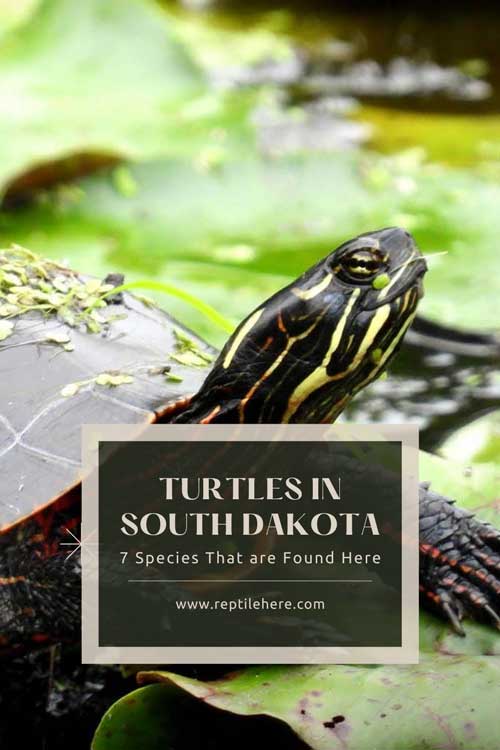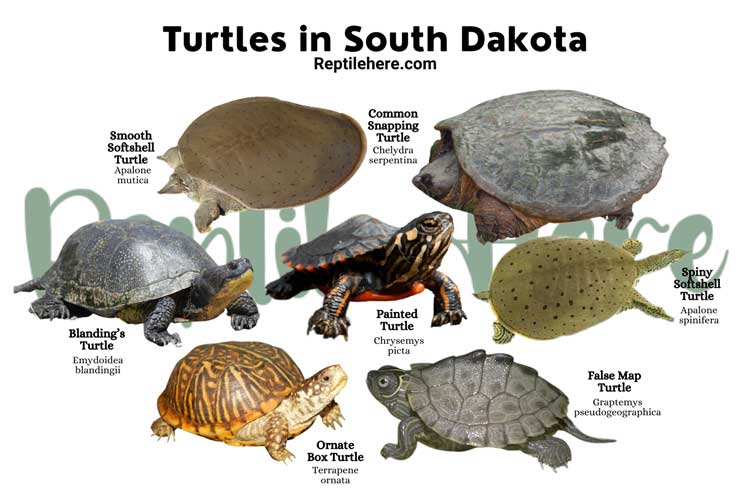Turtles in South Dakota – 7 Species That are Found Here
South Dakota is home to 7 species of turtles, which include common snapping turtles, painted turtles, and false map turtles, among others. All of these species are native to the Northcentral state of the US.
Besides the common snapping turtle and the painted turtle, the rest of the species in South Dakota are labeled as endangered, threatened, or rare. And this puts them under special monitoring in the state.
Some of the turtles, e.g. the Blanding’s turtle, are also rarely spotted in the state and this makes it unclear if they’re still existing within the borders of this state.
The list below discusses all 7 native turtles of South Dakota and key facts about each of them, including the habitat, diet, physical appearance, average adult size, conservation status, and other helpful info.
7 Types Of Turtles in South Dakota
Contents
1. Common Snapping Turtle

- Scientific name: Chelydra serpentina
- Common name: Snapping Turtle
- Family: Chelydridae
- Size: 8 to 18 1/2 inches
- Lifespan: 30 to 50 years or more
- Conservation status: Least Concern
The common snapping turtle is one of the most popular turtle species across the US states and is also found within the borders of South Dakota. These snapping turtles in South Dakota are unprotected and can be legally owned as pets.
An average common snapping adult turtle is pretty large and has a shell length of 18½ inches long. It is easily recognizable for this large size plus an intimidating appearance!
This species has a chunky head, a long tail, strong claws, and large webbed feet. The shell color is black or olive and has no distinct pattern. These South Dakota snapping turtles are also known for their hook-like powerful jaws—they’re so strong that these turtles eat other turtles!
You’ll find them in waterbodies with muddy bottoms. Examples include marshes, ponds, lakes, rivers, and even shallow streams. They generally prefer waters with aquatic vegetation in plenty and foods such as fish, frogs, birds, etc.
These South Dakota turtles generally show docile behavior but can get quite aggressive if taken out of water. The best way to calm it is to take it back to the waters, where it feels safe.
2. Painted Turtle
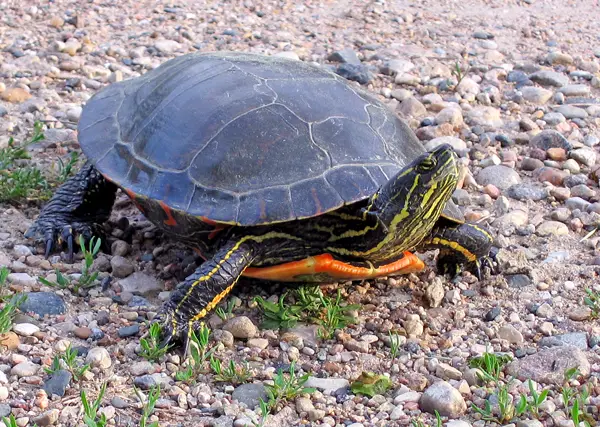
- Scientific name: Chrysemys picta
- Common name: Painted Turtle
- Family: Emydidae
- Size: 4 to 6 inches
- Lifespan: 30 to 50 years
- Conservation status: Least Concern
The painted turtle is one of the most recognizable turtle species in South Dakota, thanks to its beautiful and unique coloring. The bright reds and yellow-green markings on its shell, head, and limbs are no doubt a beauty to behold!
This painted turtle sub-species in South Dakota has been observed to live near water bodies with minimal movements. Examples include marshes, ponds, slow-moving streams with sandy/muddy bottoms, small lakes, etc.
They also prefer areas with aquatic plants in plenty as they make their primary food source in the wild.
One interesting fact about these South Dakota turtles is their ability to hold their breath for up to 30 hours when inside temperate water. Moreover, they’re capable of standing dominant in freezing cold waters for up to 4 months.
Unfortunately, it’s not easy to establish the population of these turtles in South Dakota. This is because most people who pet them end up releasing them back into the wild. This contributes to an ever-expanding range plus unstable reproduction rates for these turtles.
3. Smooth Softshell Turtle
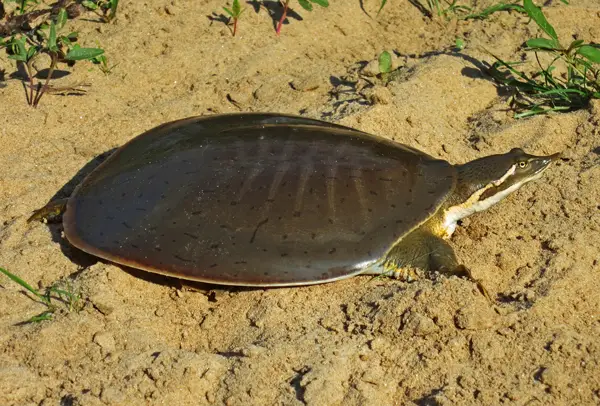
- Scientific name: Apalone mutica
- Common name: Midland Smooth Shell
- Family: Trionychidae
- Size: 6 to 13 inches
- Lifespan: 40 to 60 years
- Conservation status: Least Concern
The smooth softshell turtle boasts its position as the fastest turtle on land in South Dakota! Though most people believe these turtles are slow-moving, they must be quick to enable them to outrun their predators given that their soft shells don’t offer much protection.
Shell color of this turtle species ranges from olive to dark brown. The upper part of its shell features dark markings (with female markings appearing in a blotchier pattern than the males’)
The shell of these turtles also appears rounder and flatter, just like other softshell species.
These turtles like inhabiting waterbodies like rivers and streams in South Dakota that provide an abundance of mud or sand at the bottom. They can also be found in stagnant waterbodies.
Smooth softshell turtles of South Dakota are omnivorous and their diet revolves around aquatic vegetation and insects. However, they have been observed to like meat more than plant matter and will mainly eat snails, insects, and fish.
4. Spiny Softshell Turtle
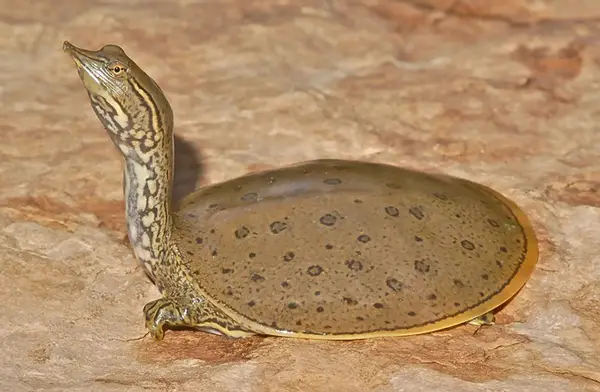
- Scientific name: Apalone spinifera
- Common name: Spiny Softshell Turtle
- Family: Trionychidae
- Size: 5 to 9 inches (males), 12 to 20 inches (females)
- Lifespan: 30 to 70 years
- Conservation status: Least Concern
The Spiny softshell turtle is a medium-to-large freshwater species that live in South Dakota’s lakes, streams, and rivers with muddy or sandy bottoms and little or no vegetation.
Female spiny softshell turtles are usually larger than males. And unlike other turtles, this species has a flexible, leather-like carapace that’s extremely rounded and flattened. The shell color can be olive grey or yellow-brown.
Just like other softshell turtles, this species also has a snorkel-like snout.
The young ones feature well-defined round spots that are easily visible on the shell (though these spots become invisible as they transition to adulthood).
Spiny softshell turtles in South Dakota tend to eat anything they find in the waters including crayfish, insects, small fish, and so on. They hunt by burying themselves in the mud or sand while keeping their head uncovered to grab food as it swims by.
These turtles are also able to breathe underwater by taking in oxygen through their throat skin. This is a useful adaptation given that they don’t spend a lot of time out of water.
Other adaptations of these turtles include webbed feed, long claws, and extremely flat shells that enable them to quickly swim away from predators and burry in the muddy bottom of the waters they reside in.
Also read: Turtles in New Jersey
5. Blanding’s Turtle
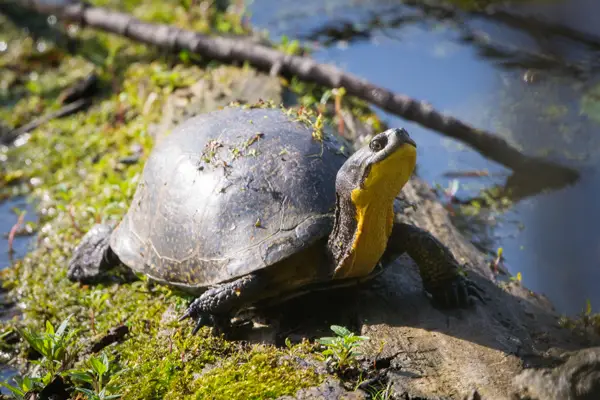
- Scientific name: Emydoidea blandingii
- Common name: Blanding’s Turtle
- Family: Emydidae
- Size: 5 to 8 inches
- Lifespan: up to 80 years (or more!)
- Conservation status: Endangered
Blanding’s Turtle is also known as the “turtle that smiles” and is named in honor of William Blanding, the American naturalist.
This turtle is semi-aquatic and is categorized under endured species in South Dakota. It is mainly concentrated in the northern half of this state, but its population is quite scattered—making it hard to find.
The Blanding’s turtle has a dark oval shell covered with faint yellow speckles. The lower side of its shell is usually yellow with black patches.
Blanding’s turtle in South Dakota prefers living in marshy habitats. And the fact that it’s losing these favorite habitats is one of the reasons causing its population to decline fast.
Because this turtle species in South Dakota is omnivorous, it feeds on leatherworks, crayfish, and aquatic invertebrates.
It also occasionally feeds on plants and doesn’t rely on water to help it sallow its food as it’s the case with most turtle species.
6. False Map Turtle
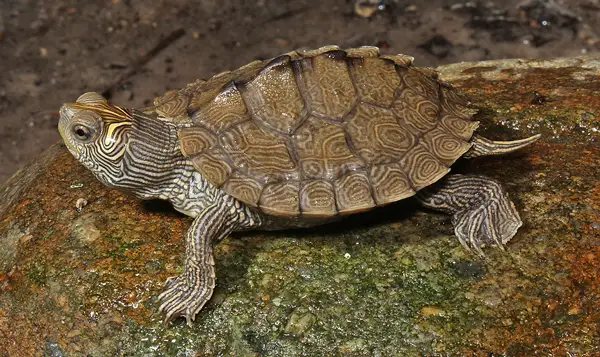
- Scientific name: Graptemys pseudogeographica
- Common name: False Map Turtle, Sawback Turtle
- Family: Emydidae
- Size: 6 to 10 inches (females), 3.5 to 6 inches (males)
- Lifespan: 30 to 50 years
- Conservation status: Least Concern
The False map turtle is another turtle species found in South Dakota. This turtle’s preferred habitat in South Dakota includes rivers, streams, and oxbow lakes of the Missouri and Mississippi river systems.
It is an excellent swimmer and prefers moderate currents and deep waters.
Its upper shell coloring ranges from olive to dark brown, with light-colored lines on its limbs. It also features a line behind its eye that forms a backward “L” shape. The map pattern on its carapace tends to fade as the turtle ages.
Since this map turtle of South Dakota is omnivorous, it feeds on aquatic insects and animals as well as vegetation. It is fond of river snails and crustaceans. Don’t forget it has strong jaws and can give a nasty bite!
Like most of the other aquatic turtles of South Dakota, this map turtle spends most of its waking hours sunning.
The false map turtle is quite shy and quietly and swiftly slides into the water at the slightest signs of disturbance. It likes spending most of its time in water and is most active in climate conditions of over 85 degrees Fahrenheit.
7. Ornate Box Turtle
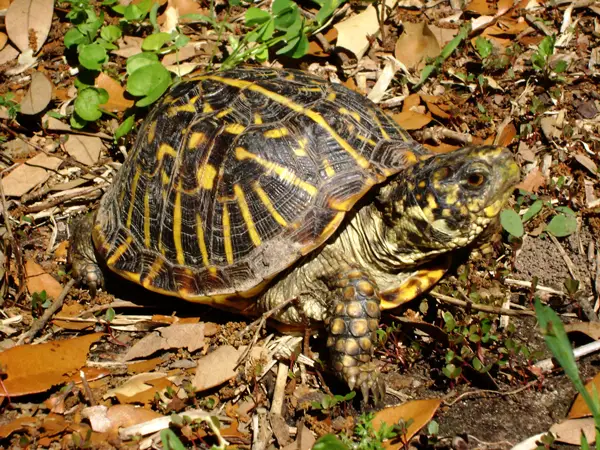
- Scientific name: Terrapene ornata
- Common name: Ornate Box Turtle
- Family: Emydidae
- Size: 5 to 7 inches
- Lifespan: 40 to 60 years
- Conservation status: Near Threatened
Ornate box turtles are present in South Dakota and are recognized by the beautiful pattern on their carapace. This eye-pleasing pattern is sometimes referred to as a starburst pattern.
Their skin is grey and may feature yellow or white spots. Male heads occasionally feature a green color.
Though there exists a little distinction between the males and females of these South Dakota box turtles, the males are generally smaller than the females.
During hot weather, this turtle requires water to help regulate its body temperature.
The South Dakota species of turtle are known to hibernate in burrows during cold weather. They’re also capable of surviving in frozen soils for several days.
Being omnivorous in nature, and opportunistic feeders, these turtles will gladly eat anything available to them in their habitat or what’s abundant in a given season.
They have been observed eating fruits, vegetables, grasshoppers, and various other insects.
Also, these box turtles are pretty shy and don’t like being handled excessively. As such, you may want to avoid approaching them suddenly while in the wild in South Dakota.
Related: Turtles in Florida
Conclusion
That’s it for the 7 turtle species of South Dakota, all of which are native to the state. They include the common snapping turtles, painted turtles, spiny softshell turtles, smooth softshell turtles, Blanding’s turtles, false map turtles, and ornate box turtles.
Remember, only the snapping turtles and painted turtles of South Dakota hold no special status and are not illegal to hunt or collect. The other 5 species are protected and illegal to keep as pets or hunt, even with a valid fishing/hunting license.
We hope that this guide has answered your question on what turtles live in South Dakota and their defining characteristic including physical appearance, habitat, diet, and other key facts.
